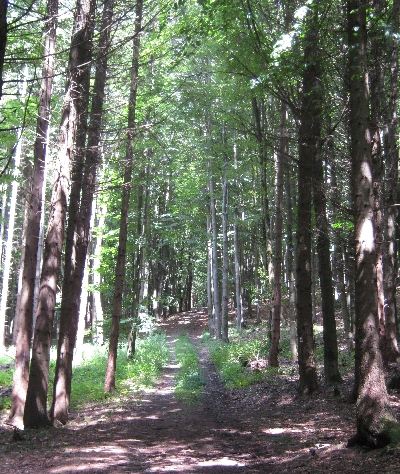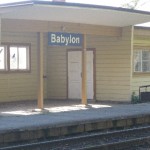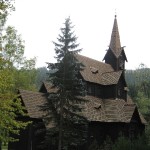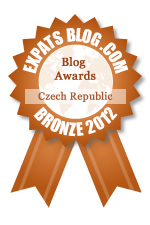We spent the second week of our recent holiday, Tuesday 19th – Sunday 24th July, staying as we had previously done in October 2010, in a delightfully restored house dating from the first decade of the twentieth century that belongs to Jack, an Irish member of the St. Clement’s congregation. It is situated in the somewhat unusually named village of Babylon, which lies between the town of Domažlice and the German border, in the far west of Bohemia.
The nearby range of rolling wooded hills are known as Ceský les which is sometimes anglicised as ‘Bohemian Forest’. These hills are far lower than the Krkonoše Mountains, the highest point being Cerchov at 1042 metres. The border between the Czech Republic and Germany runs along the top of the hills which are known as the Oberpfälzerwald where they extend across the border into Bavaria.
Ceský les and the surrounding border area was part of the Sudetenland from which the Sudetendeutsche population was expelled following the end of the Second World War in 1945. It was never really re-populated as, following the Communist coup in 1948, it became a restricted zone where only trusted supporters of the regime such as members of the secret police, were allowed to live and work. The average Czech citizen was not allowed to set foot in this border area for fear that they might try to escape from their Communist paradise to the capitalist state of neighbouring West Germany.
One very positive consequence of this lack of human activity for a period of over forty years is that the natural flora and fauna were allowed to flourish almost completely undisturbed. Now Ceský les has protected status as a National Park thus preserving this wonderful environment whilst making it available to walkers and cyclists who can explore its beauty by following a whole series of waymarked routes that traverse the area.
During our walks in Ceský les, we twice walked through the village of Pec, (pronounced ‘pets’) which gave us a sense of déjà vu having stayed in Pec pod Snežkou in the Krkonoše Mountains the previous week. As I explained in that post, ‘pec’ means furnace as this village also once had a furnace for the smelting of locally mined iron ore. The correct full name of this ‘Pec’ is ‘Pec pod Cerchovem’ meaning ‘the furnace under the mountain Cerchov’. Sybille actually suggested that I should entitle this post ‘From Pec to Pec’!
Within the village we both enjoyed this mural painted on the side of the village pub or hospoda. Whilst it is five kilometres to the top of Cerchov, it is only five metres around the corner to the entrance of the pub! Which direction would you prefer to walk? Also in Pec is this Calvary with somewhat unusual artwork compared to what one commonly sees in the Czech Republic.
Another attractive village that we also walked through twice was Trhanov. In the centre of the village is this recently renovated (at least on the outside) Church. As ever, we could not access the interior as the doors were locked.
Also in Trhanov, we enjoyed liquid refreshment and, on our first visit, shelter from a sudden heavy shower, in Restaurace U Svatého Jána. This Bar-Restaurant has a most delightful location, just down from the Church and overlooking a small lake.
The Ceský les is remarkably attractive and unspoilt area and very peaceful. It does get visitors, both native Czechs and Germans from across the border. But they are not overly numerous and we only met a handful of other walkers and the occasional mountains bikers during our walks along the various waymarked trails.












Recent Comments